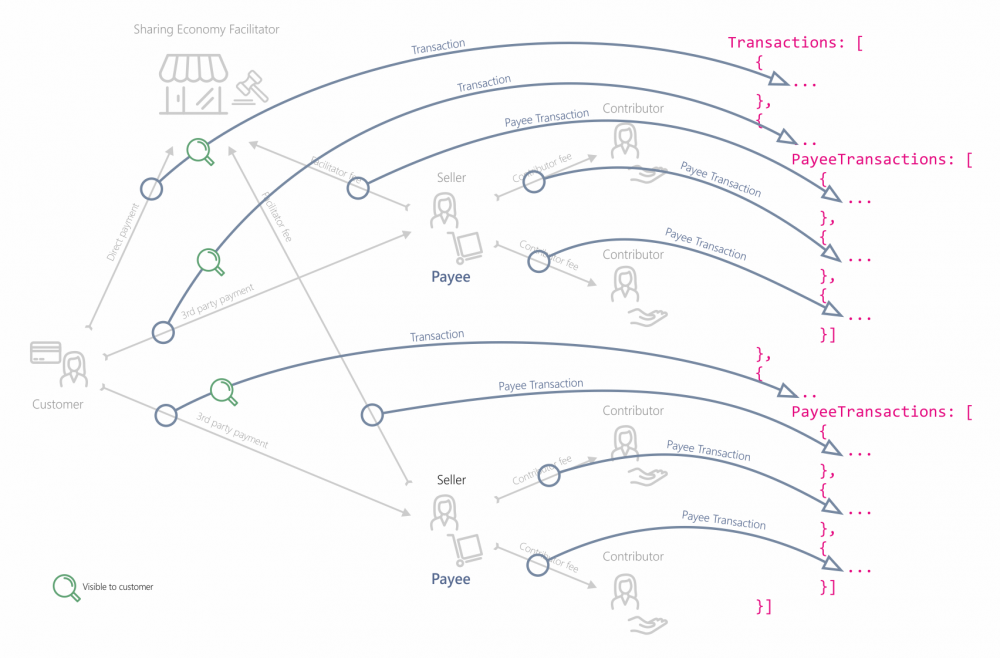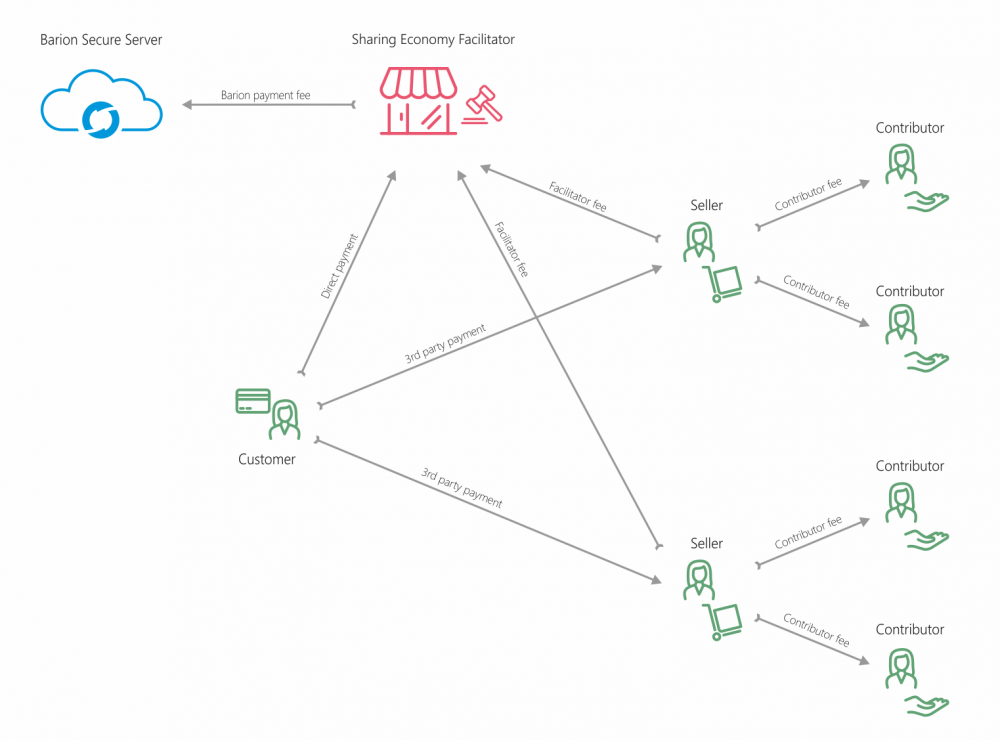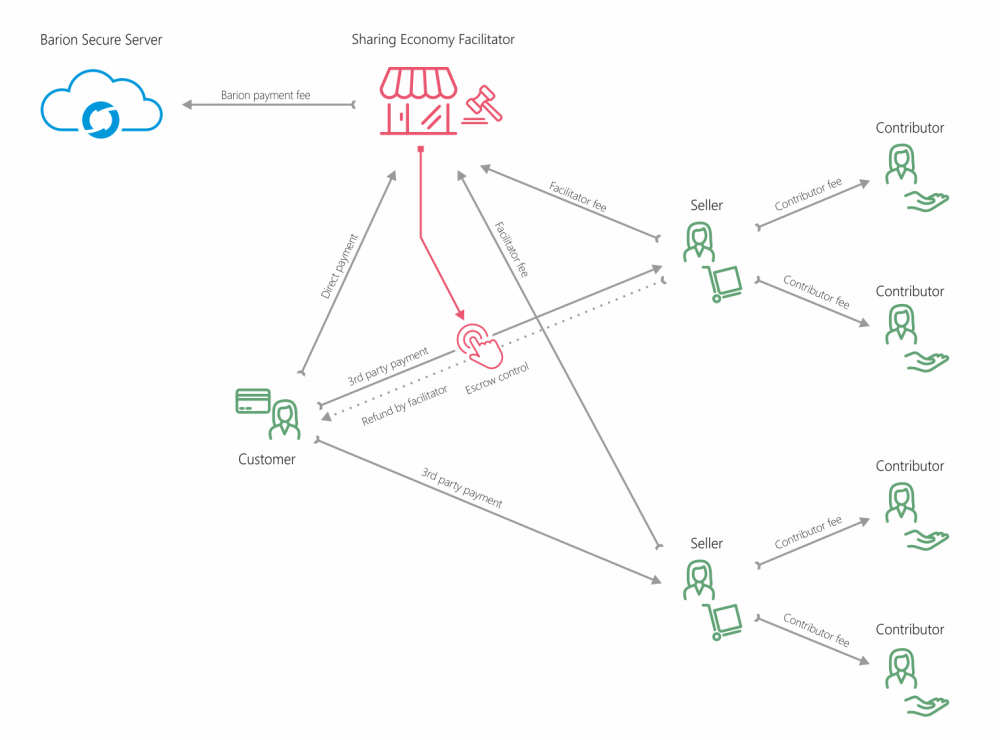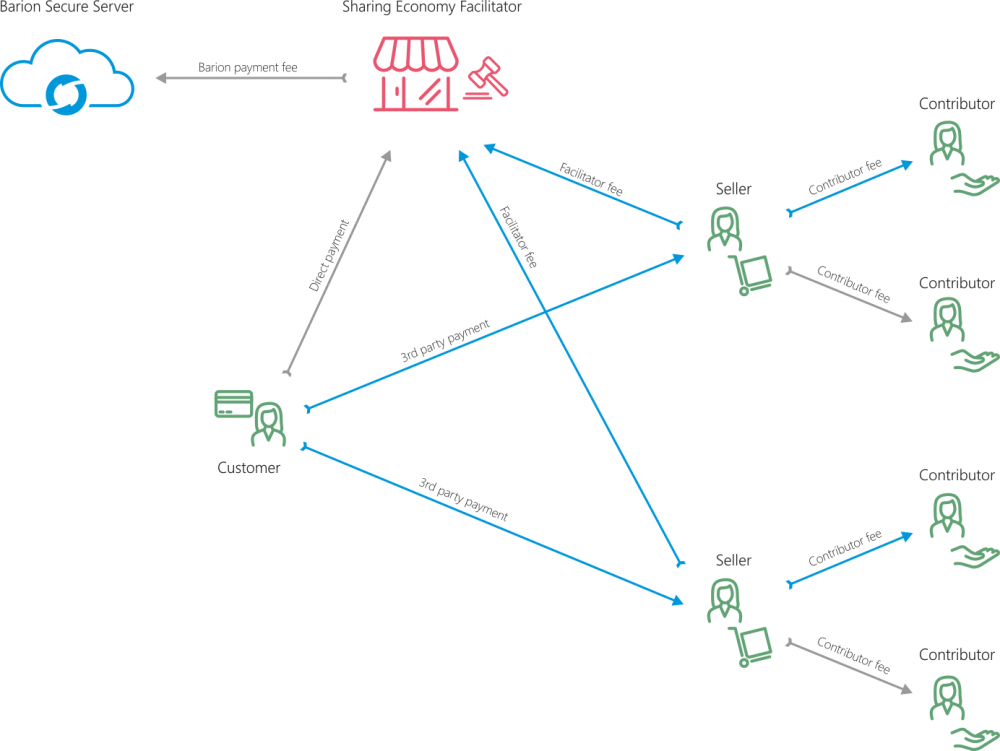C2C Payments: Difference between revisions
No edit summary |
(Undo revision 4337 by [email protected] (talk)) Tag: Undo |
||
| (31 intermediate revisions by 5 users not shown) | |||
| Line 1: | Line 1: | ||
{{PageTitle|title= | __NOTOC__ | ||
{{PageTitle|title=Barion Bridge - payments for platforms}} | |||
==Barion Bridge overview== | |||
Barion Bridge makes it possible for companies to facilitate payments between people or other parties. There are roles, as indicated on the diagram. | |||
*The Customer is the user who uses the services of or buys goods from the Seller (or multiple Sellers in case of marketplaces) and pays the Seller directly. | |||
*The Facilitator, the company that facilitates the service is organizing the payment with the Barion API. The Facilitator is able to transfer a fee from each payment to herself and to one or more Contributors. | |||
{{NotificationBox|title=Please note|text=The Customer does not need a Barion account, but the Seller and Contributors do.|color=#1993c7}} | |||
{{NotificationBox|title=Note|text=Barion Bridge payments (where a payment is credited to a Barion Wallet other than the shop owner's) can be enabled or disabled per Barion shop, and are disabled by default. Get in touch with customer support (using the Customer service tab online or the Other>Help screen in the Barion app) if you'd like to enable it for one or more of your Barion shops.|color=#1993c7}} | |||
Barion transaction fees are always covered by the Facilitator, no other parties pay transaction fees to Barion. | |||
[[CodeSamples|Code Samples]] are available. | |||
Examples of use for such payments: | |||
*Sharing Economy business model (such as Uber) | |||
*Marketplaces, where shopper may buy from multiple Sellers in one transaction | |||
*Where law mandates direct payment to Seller, e.g. in certain insurance scenarios | |||
*To optimize taxation | |||
[[file:Sharing-economy.png|1000px]] | [[file:Sharing-economy.png|1000px]] | ||
== | ==Barion Bridge with escrow== | ||
The Facilitator has the option to control the payment of the Customer to Seller, by placing the sum in an escrow and decide about fulfillment at a later time, such as when the delivery is confirmed. The funds can be partially or completely refunded to the Customer in case Seller does not deliver properly. | |||
For further details about escrow please check out [[Reservation_payment|Payments with reservation / escrow]]. | |||
For further details about facilitator or contributor fees check out [[Payee_transactions|Payee transactions]]. | |||
For further details about Barion Bridge payments please check out [[Facilitated_payments|Marketplace, sharing economy, and facilitated payments]]. | |||
[[file:sharing-economy-escrow.png|1000px]] | [[file:sharing-economy-escrow.png|1000px]] | ||
== | =="Uber" style simple sharing economy example== | ||
[[ | If "Uber" was using Barion, the passenger would be the Customer, and the Driver would be the Seller. "Uber" would ask for a fee from the driver, as the blue lines indicate. Barion transaction fees would be payed by "Uber". Drivers would need a Barion account set up before the first ride. Automatic charging would | ||
be solved by [[Token_payment|Token payments]]. | |||
For further details about facilitator or contributor fees check out [[Payee_transactions|Payee transactions]]. | |||
For further details about Barion Bridge payments please check out [[Facilitated_payments|Marketplace, sharing economy, and facilitated payments]]. | |||
[[file:sharing-economy-uber.png|1000px]] | [[file:sharing-economy-uber.png|1000px]] | ||
=="Marketplace with agents" sharing economy example== | =="Marketplace with agents" sharing economy example== | ||
This example shows a marketplace, where multiple Sellers sell goods or services to the Customer, and both the Facilitator and third party agents receive a fee. | |||
For further details about Barion Bridge payments please check out [[Facilitated_payments|Marketplace, sharing economy, and facilitated payments]]. | |||
For further details about facilitator or contributor fees check out [[Payee_transactions|Payee transactions]]. | |||
Please check out the [[Marketplace_Example|detailed example of a marketplace payment]] page for more informations. | |||
[[file:sharing-economy-marketplace.png|1000px]] | [[file:sharing-economy-marketplace.png|1000px]] | ||
==Barion Bridge transactions mapped to API structure== | |||
The following diagram helps developers match the Barion Bridge payment structure the the API Json structure. | |||
[[file:sharing-economy-api-mapping.png|1000px]] | |||
Latest revision as of 06:50, 24 April 2024
Barion Bridge - payments for platforms
Barion Bridge overview
Barion Bridge makes it possible for companies to facilitate payments between people or other parties. There are roles, as indicated on the diagram.
- The Customer is the user who uses the services of or buys goods from the Seller (or multiple Sellers in case of marketplaces) and pays the Seller directly.
- The Facilitator, the company that facilitates the service is organizing the payment with the Barion API. The Facilitator is able to transfer a fee from each payment to herself and to one or more Contributors.
Barion transaction fees are always covered by the Facilitator, no other parties pay transaction fees to Barion.
Code Samples are available.
Examples of use for such payments:
- Sharing Economy business model (such as Uber)
- Marketplaces, where shopper may buy from multiple Sellers in one transaction
- Where law mandates direct payment to Seller, e.g. in certain insurance scenarios
- To optimize taxation
Barion Bridge with escrow
The Facilitator has the option to control the payment of the Customer to Seller, by placing the sum in an escrow and decide about fulfillment at a later time, such as when the delivery is confirmed. The funds can be partially or completely refunded to the Customer in case Seller does not deliver properly.
For further details about escrow please check out Payments with reservation / escrow.
For further details about facilitator or contributor fees check out Payee transactions.
For further details about Barion Bridge payments please check out Marketplace, sharing economy, and facilitated payments.
"Uber" style simple sharing economy example
If "Uber" was using Barion, the passenger would be the Customer, and the Driver would be the Seller. "Uber" would ask for a fee from the driver, as the blue lines indicate. Barion transaction fees would be payed by "Uber". Drivers would need a Barion account set up before the first ride. Automatic charging would be solved by Token payments.
For further details about facilitator or contributor fees check out Payee transactions.
For further details about Barion Bridge payments please check out Marketplace, sharing economy, and facilitated payments.
"Marketplace with agents" sharing economy example
This example shows a marketplace, where multiple Sellers sell goods or services to the Customer, and both the Facilitator and third party agents receive a fee.
For further details about Barion Bridge payments please check out Marketplace, sharing economy, and facilitated payments.
For further details about facilitator or contributor fees check out Payee transactions.
Please check out the detailed example of a marketplace payment page for more informations.
Barion Bridge transactions mapped to API structure
The following diagram helps developers match the Barion Bridge payment structure the the API Json structure.




